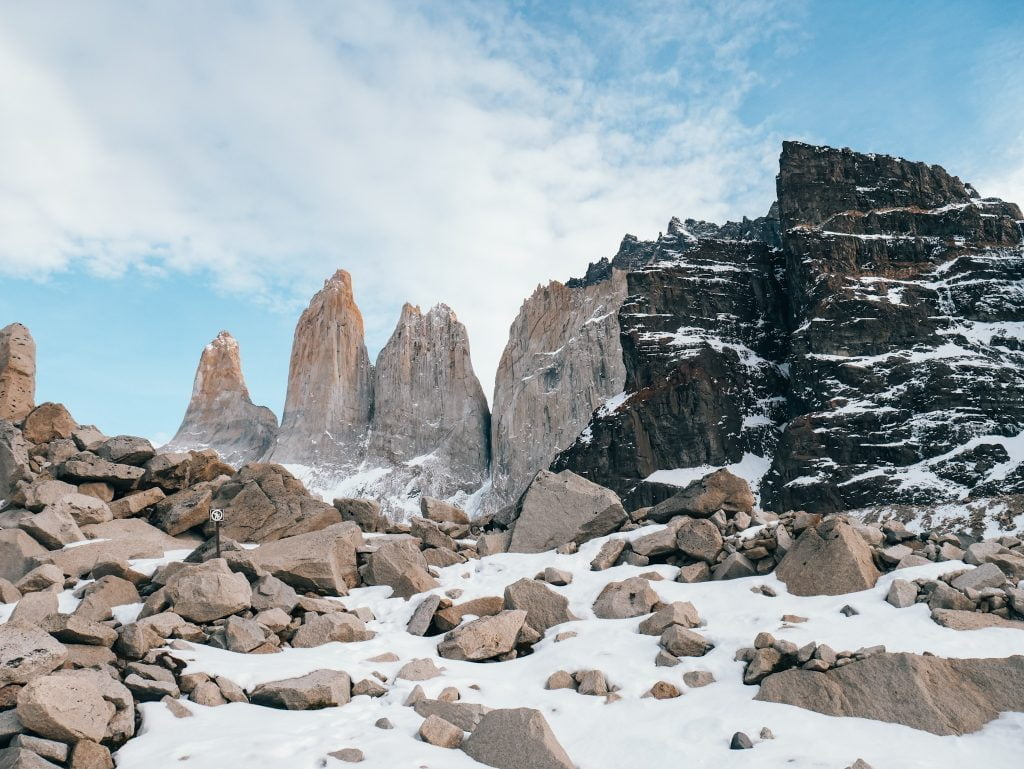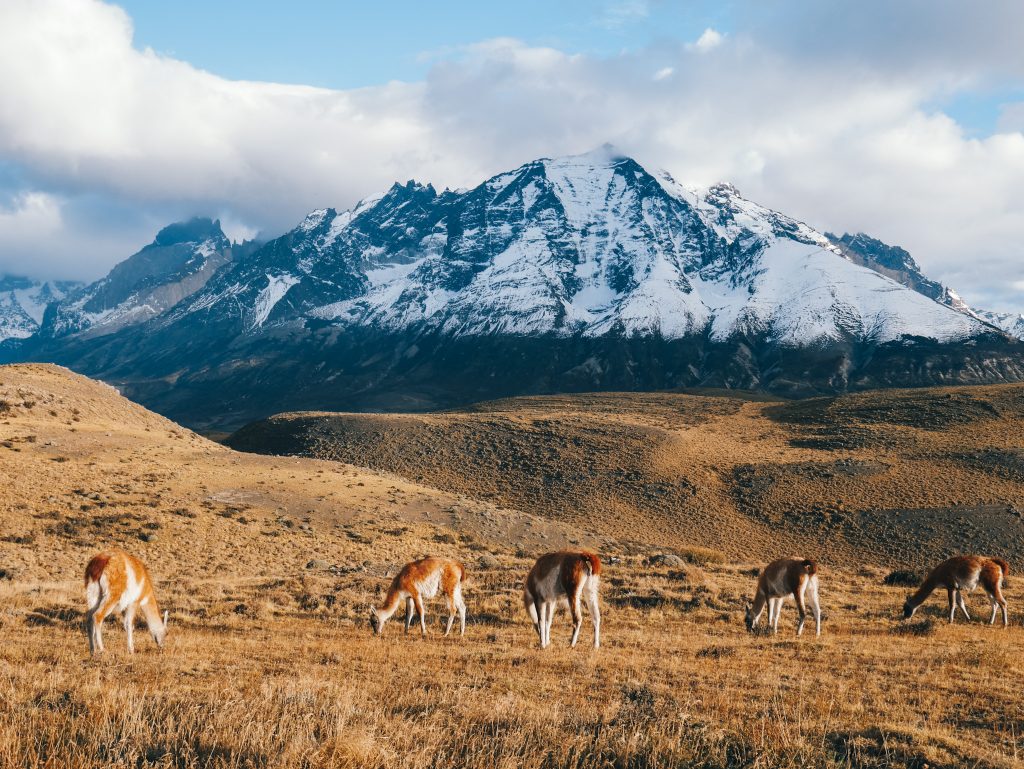Our loop through South America brought us to southern Chile at the end of May. Visiting Patagonia during the low season offered some extra challenges at times, but the quiet trails and winter beauty made it worth every second to us. Here are some important things to know before visiting Torres del Paine in the winter.

Pros & Cons to Visiting Torres del Paine in the Winter
All of the information in the sections below is simplified in this table. There are pros and cons to visiting in any season, so when you choose to go is really up to you!
We personally loved being there in the winter because we enjoy cooler weather and dislike crowds. To us, that was worth the little extra effort in planning our adventure here.

Weather
Temperatures: May through September are the coolest months in Torres del Paine with average temperatures ranging from 40˚F to 46˚F (4˚C to 8˚C) during the day, but dropping below freezing at night and on cooler days.
Winds: This area is also famous for its wild winds, some gusts reaching over 100 mph! However, winds die down a bit more May through September. We only encountered a short spurt of gusty winds at Glaciar Grey. We were glad that the air was pretty still during our time there.
Precipitation: Torres del Paine gets precipitation throughout the entire year, but September and October are often the driest months. Storms generally blow over quickly, but you’ll definitely want waterproof clothing.
While you may encounter snow if visiting Torres del Paine in the winter, heavy accumulation in the valley is infrequent. Snow will stick around longer at higher elevations and there may be icy spots along the trails.

Sunshine: You’ll likely have sunny days when visiting in the winter. We had plenty of sunshine with periods of cloudiness as clouds rolled over the valley. Morning fog will sometimes hang low in the valley but burn off as the day goes on. The sun rises after 9:30 a.m. and sets just before 6 p.m. during the winter months, so your daylight hours in the park are more limited.
The weather in Torres del Paine is pretty unpredictable and is known to change rapidly. We were lucky to encounter sunny days with mild temperatures in the winter, but the winds and snow can cause trail closures. So, the best thing you can do when embarking on winter trips in the park is to monitor the weather in the days leading up to your planned excursion.

Transportation
To & From the Park
When visiting Torres del Paine in the winter, options for getting to and from the park are a little more limited. The buses that run a few times a day in the high-season are the most budget-friendly option. However, they stop making regular daily trips to and from the park starting May through September. We have seen some information saying that a couple companies run one bus per day to and from the park in the winter, but when we were there, there were none operating.
Though buses may not be a concrete option, tours and car rentals are still available in the low season. The road to the park is paved and well maintained. Though it is the most expensive, renting a car is a great option no matter the time of year as it provides the most flexibility.

Inside the Park
Within the park, transportation is a little more difficult in the winter as well. The buses running between trailheads/lodges were not operating, so it was nice to have the tour van take us to various spots instead of walking. Excursions, such as trips across Lago Pehoé and Lago Grey, decrease the number of excursions in the winter.
Costs
For foreign adults, the park fee begins at CLP 31,200 as of 2024.
Update: Since the pandemic, tickets must be purchased online in advance from the CONAF webpage. Additionally, we don’t think the park offers the winter discount anymore.
Previously, you had to buy your ticket at the park entrance station in cash and the cost was halved during the winter. Check the park website for more details and updated fees.
Various costs in and around the park are lower in the winter, including tours restaurants, and hotels.

Lodging & Camping
Many of the refugios/hotels in Torres del Paine close during the winter. While there are no huge crowds in the off season, you should still book your accommodation in advance if you want to stay in the park due to the limited options.
Explora and Hotel Lago Grey are the only hotels we know of in the park that stay open all winter. Some lodges stay open to a limited capacity, such as allowing travelers to use the restrooms or purchase food, but not offering rooms for accommodation. We stayed in Puerto Natales and there were still quite a few hotel options available last minute in the winter.
If you plan to camp and/or trek in the park, note that it is required to have a reservation at each campsite you want to stay at and it may be required to have a guide. Sites are run by three organizations: Las Torres (affiliated with Fantastico Sur), CONAF, and Vertice. Bookings can be made in advance through their webpages.
Some of the campgrounds and refugios close in the winter. CONAF sites generally close May through September, Fantastico Sur sites close from May through September or October, and Vertice sites are closed May through October or November. If you take a winter tour, campsite reservations will usually be organized for you.
Closures can depend on conditions, so check the operational status of different sites, lodges, etc. on the CONAF site here.

Winter Activities in Torres del Paine
We absolutely loved exploring Torres del Paine in the winter. We were lucky to have great weather and the park was pretty empty. One huge plus to visiting during low season was the abundant wildlife. You’re more likely to spot a puma as the crowds thin out and they wander to the lower elevations of the valley in the cooler months. We also saw tons of different birds, a fox, and many guanacos.

Many of the park highlights are still accessible in the winter. You can drive to quite a few viewpoints and trailheads or take a day tour of the park. A guide is generally not required to access many of the viewpoints and short trails in the winter.
The trail to the famous Mirador las Torres is open in the winter too. Contrary to the typical long line of hikers making their way to the mirador in the summer, we had this trail mostly to ourselves on a sunny winter day. This in itself made going here in the winter beyond worth it for us. Check the trail permissions and guide requirements here, as one may be needed to complete your intended hike. The park often requires a guide for many trails May through August.
Note that even the attractions that claim to be open in the winter are subject to closures due to high winds and weather. Closures can even happen in the summer!

Extra Info & Tips
Here are a few extra logistics to keep in mind if you are planning on visiting Torres del Paine in the Winter.
Winter runs from June through August in the Southern Hemisphere. Shoulder months are May and September.
Extra Gear may be needed to hike here in the winter. Warmer layers, boots suitable for snow, and maybe even spikes/crampons may be needed. If you do not own or bring these items yourself, there are gear shops that rent out equipment in Puerto Natales. Some tours may provide certain gear as well, but be sure to check before the day of your excursion.
The park entrances open at 8:00 a.m. and close at 7 p.m. in the winter. There are three main administrative spots in the park. At the entrance stations you can obtain some park information. These hours are subject to change, so always check the daily report on the park website before your visit.

It is mandatory to have a guide for the W Trek and many other hikes. From May through August, you must have a guide to hike various trails in the park.
The O Trek is closed in the winter. This also means that the full Q Trek is not an option. CONAF is in charge of the closure and opening of this trail, and the exact dates aren’t often certain. But, the trail usually opens in November and closes at the end of April.
Like this Post? Pin it!





Thanks for the great post.
Is it really doable and legal to make the trip to Mirador las Torres in winter alone?
Greetings from Germany.
Greetings!
Many times in the winter, the park implements the requirement to have a guide to hike to Mirador Las Torres even for just a day hike. The exact times they implement this seem to be based on the conditions and there is no set date, which makes it kind of difficult to plan ahead. When we visited in the winter, it was required. The link below contains info from the official CONAF website on the guide requirements and hours for various trails in the park (you may need to translate the page). We hope this helps!
https://parquetorresdelpaine.cl/tarifas-y-horarios/